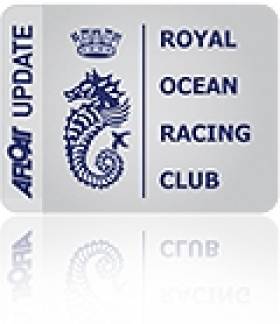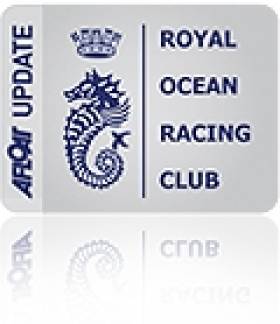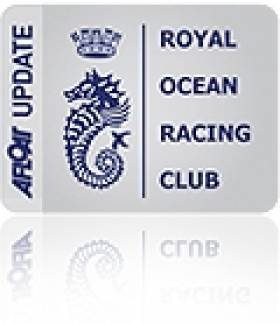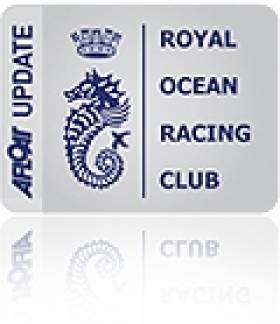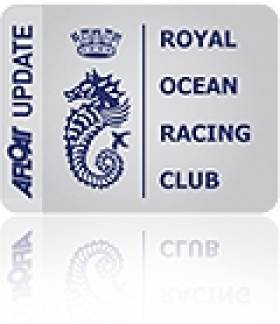Displaying items by tag: Michael Boyd
#rorc – With over 400 yachts crewed by thousands of sailors from over 30 different nations, the 2015 Royal Ocean Racing Club's (RORC) Season's Points Championship has the largest fleet of offshore racing yachts anywhere in the world. This year, under Irish Commodore Michael Boyd, the RORC is celebrating its 90th anniversary and a record attendance is highly likely.
The first race of the series in the English Channel was the Cervantes Trophy Race, which started on 2nd May 2015. Organised by the Royal Ocean Racing Club in association with the Société des Régates du Havre and the Royal Yacht Squadron, the 114 yachts entered were set a 135 nautical mile course from the Squadron Line to Le Havre.
The first leg took the fleet downwind to Anvil Point and the DZB Buoy, with 20 knots of wind from the east. It was a terrific start to the race and with spinnakers set most yachts were enjoying double digit boat speed. The wind was funnelling through Hurst Narrows and the increased wind speed caused a good few broaches, but back under control, the competitors continued downwind to Anvil Point where it was spinnakers down and on to the wind for the 100 mile leg towards Le Havre. The forecast was showing a massive shift in the wind direction from easterly through the south to settle in the southwest. With this in mind most of the boats stayed on port tack and headed for the Cap de la Hague in anticipation of the change. With the forecast changing and rain squalls running up the channel the crossing of the Baiy de la Seine and negotiating the tricky tidal streams and shifty winds was to prove a crucial part of the race.
Géry Trentesaux's new JPK 10.80, Courrier Du Leon was the overall winner, taking under 20 hours to complete the course. "This is the first time we have raced the boat and we are delighted with the performance." smiled Géry. "We haven't really tuned up the boat but she will be a nice fast boat once we have had some time on the water. IRC 3 is a very competitive class and it looks like this will be a really good season. The Cervantes Trophy Race had a lot of upwind sailing and I was very surprised how fast Courrier Du Leon was on the wind. The key area of the race was the approach to le Havre, we stayed south and tacked just off Barfleur, which was perfect. Courrier Du Leon will be taking part in the North Sea Race and I am sure I speak for all sailors when I say, we will all miss Piet Vroon, who is not sailing at the moment due to a back operation. We all wish him a speedy recovery."
In IRC Canting Keel, IMOCA 60, Artemis Ocean Racing took Line Honours in 15hrs 23mins 58secs and the class win from Chris Le Prevost's IMOCA 60, Rosalba, sailed by Andy Greenwood. Derek Saunders' CM60, Venomous crewed by the Windward Sailing Team, was the winner of IRC Zero. Ned Collier Wakefield's Class40, Concise8 took the Class40 win, 22 minutes ahead of David Pearce's Forty Shades of Grey, with Bertrand Gregory's Rififi third.
In IRC One, there was an emphatic win for Nick Jones' First 44.7 Lisa, which won the class by nearly an hour on corrected time from Mark Emerson's Rodman 42, Phosphorus. Edward Broadway's Ker 40, Hooligan VII was third. In IRC Two, local sailor Gilles Fournier J/133 Pintia was the winner by just over ten minutes on corrected time and was also second overall Gilles was sailing with French legend Bruno Troublé who undoubtedly brought a lot of technical and tactical experience to the team. RORC Admiral, Andrew Mc Irvine's First 40, La Réponse sailed by Jason Owen was second in IRC One and Peter Rutter's Grand Soleil 43, Quokka 8, with RORC Commodore Michael Boyd on board, was third.
IRC Three was won by Courrier du Leon, just under ten minutes ahead of Eric Mordret's JPK10.80, Raphaello. Holders of the Fastnet Trophy, Pascal Loison's JPK 10.10, Night and Day was third, racing two-handed with his son Alexis. 25 yachts were racing in the Two Handed Class for the Cervantes Trophy. Night and Day was the winner by just under 20 minutes on corrected time from Rob Craigie's Sunfast 3600, Bellino. Louis-Marie Dussere's JPK10.10, Raging Bee, returned from the RORC Caribbean 600 to compete and placed third in the Two Handed Class, just 31 seconds behind Bellino.
Harry Heijst's S&S 41, Winsome revelled in the upwind conditions to win IRC Four, beating Noel Racine's JPK 10.10, Foggy Dew by just over six minutes after time correction. Ludovic Melnyk's JPK 9.60, Sous Mama Boulé racing Two Handed was third.
"The RORC Season's Points Championship is the premier offshore sailing series in the world" commented RORC Racing Manager Nick Elliott. "The 2015 series will see the fleet swelled by yachts competing for the RORC blue ribbon event, the Rolex Fastnet Race, which once again has struck a chord with Professional and Corinthian sailors alike."
At the beginning of May the yachts line up to get racing miles under their belts working towards the 300 nm offshore racing required to meet the experience qualification for the Rolex Fastnet Race, as well as scoring points towards the Season's Points Championship. The Cervantes Trophy had a terrific entry list and a big thank you to the Société des Régates du Havre that has once again hosted the finish, providing a fantastic welcome for all of the participants."
Racing for the RORC Season's Points Championship continues with the 181 nautical mile North Sea Race from Harwich to Scheveningen, which starts on Friday 15th May. For full details of results for the Cervantes Trophy Race and the racing schedule for the RORC Season's Points Championship visit http://www.rorc.org
RORC Review of Caribbean 600 Video
The RORC Caribbean 600 started from Antigua on Monday 23rd February 2015. The 600nm course circumnavigates 11 Caribbean Islands starting from Fort Charlotte, English Harbour, Antigua and heads north as far as St Martin and south to Guadeloupe taking in Barbuda, Nevis, St Kitts, Saba and St Barth's, finishing back in Antigua.
Trimaran Phaedo 3 Leads RORC Caribbean 600 Fleet
#caribbean600 – 66 yachts started the 7th edition of the RORC Caribbean 600 yesterday, with hundreds of race fans watching the impressive fleet from Fort Charlotte and Shirley Heights. Irish crews are racing in several boats across the fleet, details of some are here. After a classic start in 15 knots of easterly trade winds, the fleet powered past the Pillars of Hercules, heading for Green Island where they will bear away and accelerate towards Barbuda, the only mark of the 600-mile course around 11 stunning Caribbean islands.
Lloyd Thornburg's MOD 70 Phaedo3, with Michel Desjoyeaux and Brian Thompson on board, had a conservative start with Petro Jonker's cruising catamaran, Quality Time crossing the line first. Phaedo3 lit the blue touch paper at Green Island, blasting through the surf at well over 30 knots. The lime-green machine reached Barbuda in less than two hours, well ahead of record pace and eight miles ahead of Peter Aschenbrenner's Irens 63, Paradox.
In the second start, 19 yachts in IRC Two and Three started the 600-mile race. For most of the crews racing in the smaller yachts it will be three or four days before they complete the challenge. Ed Fishwick's Sunfast 3600, Redshift, skippered by Nick Cherry, got a great start at the pin-end with Ross Applebey's Oyster 48, Scarlet Oyster, judging the inner distance mark to perfection. Andy Middleton's First 47.7, EH01 and Scarlet Oyster were the first yachts in IRC Two to reach Green Island and it is likely that these two will be neck-and-neck for the duration of the race. In IRC Three, Peter Scholfield's HOD 35, Zarafa was leading on the water at Green Island. However the Two Handed team racing Louis-Marie Dussere's JPK 10.10, Raging Bee was the leader in class after time correction.
Jonathan Bamberger's Canadian J/145, Spitfire and Joseph Robillard's S&S 68, Black Watch got the best start in the 15 strong fleet racing in IRC One. However, Jose Diego-Arozamena's Farr 72, Maximizer, revelled in the upwind start to lead on the water at Green Island. Oyster 625, Lady Mariposa, sailed by Daniel Hardy had a great leg to Green Island as did James Blakemore's Swan 53, Music which was leading after time correction.
The penultimate start featured 21 yachts racing in IRC Zero and Canting Keel, arguably the best fleet of offshore sailing yachts that has ever been seen in the Caribbean. A highly competitive start saw Piet Vroon's Ker 51, Tonnerre 4, win the pin, while Ron O'Hanley's Cookson 50, Privateer took the island shore route to perfection. Farr 100, Leopard sailed by Christopher Bake, also had a great start, controlling the boats to leeward heading for the Pillars of Hercules.
Hap Fauth's Maxi 72, Bella Mente had a sensational first leg of the race, rounding Green Island first out of the IRC Zero class, but all eyes were on George David's Rambler 88, as the powerful sled turned on the after burners. George David's new speed-machine could well break his own monohull course record; at Barbuda Rambler 88 was almost five miles ahead of the ghost track of the record set by Rambler 100.
Two of the world's most magnificent schooners were the last class to start. Athos and Adela started their match race in the pre-start and there is no doubt that the battle of the titans will continue throughout the race. Athos won the pre-start in some style, chasing Adela downwind and away from the line, before rounding up onto the breeze and crossing the line over a boat length ahead of her rival. However, Adela was far better suited to the beat up to Green Island and led as the two schooners continued their rivalry towards Barbuda.
Note: Liquid, Pamala C Baldwin's J/122 and Quality Time, Petro Jonker's Du Toit 51 catamaran retired at the start following boat damage. All of the crew are well.
Records Set To Tumble At RORC Caribbean 600
#rorc – Records are predicted to tumble for the seventh edition of the RORC Caribbean 600 this week, which has one of the most spectacular line ups of high performance boats racing anywhere in the world. Interviews with participating crews and practice action prior to the race start are contained in the above vid. A number of key Irish crews are competing including new RORC commodore Michael Boyd who features above.
Irish Sailors In Command of International Sailing in London
#rorc – London's unique position at the crossroads of world sailing communications makes it a focus of attention in the winter months. Organisations of international standing will be having key administrative and decision-making meetings in the short non-sailing winter days, decisions which will impact on the coming season and the years beyond.
Sailing's world body, the International Sailing Federation, may take itself off in November to some choice destination resort for a week-long conference, with all expenses paid for the selected delegates. But the more specialist organisations rely to varying extents on voluntary workers with limited time and resources. Thus their constitutionally-required yearly gatherings tend to be compressed into just one day for an Annual General Meeting (AGM), with effective sub committees and executive officers being relied on to see that decisions made on that day are implemented through the coming year.
It has been a typical winter season in London with the AGM of the Royal Ocean Racing Club in December, and then January saw the annual log adjudication announcements of the Royal Cruising Club - it's a cruising achievement assessment process which goes back to 1896, while the club itself is far and away the world's most senior cruising organisation, as it dates back to 1880. The RCC meeting was then followed nine days later by the Annual General Meeting of the Old Gaffers Association, founded 1963 and now maturing very well as an international body.
There was nothing at all unusual in the fact of these three meetings being held. But it was unusual that, in all three gatherings, the leading roles were filled by Irish sailors. W M NIXON takes up the story.
When Michael Boyd became Commodore of the Royal Ocean Racing Club on December 1st 2014, it was at the conclusion of a year in which Ireland had performed exceptionally well in the club's international racing programme, with a clear victory in the Brewin Dolphin Commodore's Cup series, while Anthony O'Leary's Ker 39 Antix from Cork became RORC "Yacht of the Year" after a season which included winning the club's National IRC Championship and being Captain's Boat in the Commodore's Cup squad.
But it was steady years of service on committees and in the secondary flag officer roles, rather than Irish success in the club's racing, which led to Michael Boyd's elevation to the top post, allied to his long personal involvement of participation in all the main RORC events, and many minor ones too.
And it was not the first time an Irish sailor has played a key role in this unique organisation. Back in August 1925 at its founding in Plymouth immediately after the first Fastnet Race, one of the seven skippers involved was Harry Donegan of Cork, whose 50ft cutter Gull had placed third overall in what was to prove a turning point in world sailing history.
Although the newly formed Ocean Racing Club was to more or less kidnap the Fastnet Rock to become one of its symbols, Donegan was the only skipper who had raced round it before. He had taken part in the time-honoured contests from Cork Harbour to West Cork, supporting Schull Regatta which dates back to 1884, while Baltimore regatta can probably claim similar longevity. And Harry Donegan knew West Cork well, having been producing privately distributed sailing directions for cruising enthusiasts to its harbours and anchorages since at least 1912.
But inevitably, with the RORC's initial concentration of keen and resource-rich boat-owners sailing from southeast England and focused on London, it was some time before there was another significant Irish presence in the administration of what was gradually developing as world offshore racing's central organization. However, by the 1960s, Denis Doyle of Cork was becoming much involved as a dedicated participant in the RORC offshore programme and on its committee, and by the 1970s he was a Flag Officer.
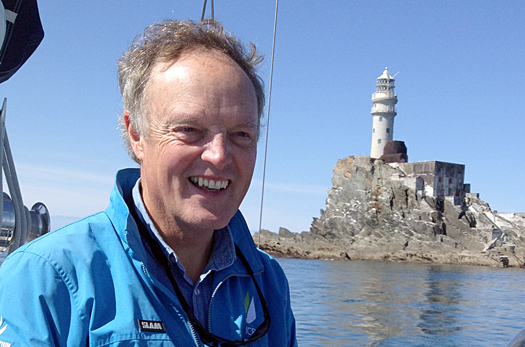
Newly-elected RORC Commodore Michael Boyd at the Fastnet Rock
Yet it was not until 1994 that Ireland provided our first RORC Commodore, John Bourke of Dun Laoghaire. In addition to being a successful offshore skipper in his own right, he had frequently been Denis Doyle's navigator in Moonduster successes, he'd also been a navigator-tactician in Ireland's fourth-placed Admirals Cup tea in 1987's thirteen-team series (our best-ever AC placing, with the Dubois 40 Irish Independent helmed by Tim Goodbody winning the Fastnet overall), and he'd served as President of the Irish Yachting Association.
But John Bourke took over the lead role in the RORC when the times were changing rapidly. Rising costs and the increase in pure professional sailing meant that major international semi-Corinthian events like the Admirals Cup were in rapid decline. And the negative effects of the Fastnet Race disaster of 1979, when 15 lives had been lost, were still being felt in turnouts for RORC events, as much more stringent regulations had led to cost increases and more demanding qualifications for participation. Then too, changing perceptions of the requirements of family life meant that the relatively selfish pattern of offshore racing participants disappearing for frequent long weekends of racing were simply no longer acceptable.
Against that, the RORC had played a key role in co-ordinating and administering the new global International Offshore Rule for handicapping. Then when rapidly evolving boat design and building techniques meant that the IOR was no longer fit for purpose, the RORC was ideally placed to oversee the changeover to the International Rating Certificate (IRC) through experience gained with the administration of the Channel Handicap system, of which elements were kept secret in order to avoid computer-aided exploitation.
So by staying with what it did best, the RORC began to prosper again. As time passed, the sheer horror of the 1979 Fastnet was slowly healed in the memory, so much so that the simple reality is that nowadays, the mythology of '79 adds to the allure of the event. In other words, the entry limit of 340 boats for the Rolex Fastnet Race 2015 was virtually filled within hours of opening. The club really does have a problem of success.
Meanwhile, it has added to the complexity of its shoreside structures by merging with the Royal Corinthian Yacht Club in Cowes. So the RORC is now a club with two clubhouses. There's the historic townhouse HQ in St James's Place in the heart of fashionable London into which it was guided in its early days by ocean racing legend John Illingworth. And there's now a summer place right beside the Royal Yacht Squadron, a rambling building with a colourful history, as members of the Royal Corinthian YC had bought it in the first place from the noted London "hostess" Rosa Lewis, who transferred her boisterous hospitality operations to Cowes during the height of the summer season.
With the new setup possibly being perceived by some members and potential members from other areas and distant nations as too much of a London-Solent nexus, it's interesting to hear that the RORC membership is continuing to increase in a very encouraging way. Clearly, these are exciting times for an organisation of increased global standing, so it's fascinating to note that the two key players in today's RORC administration are keen sailors who took their first serious steps afloat at the same time at two ports just 54 miles apart on each side of the Irish Sea.
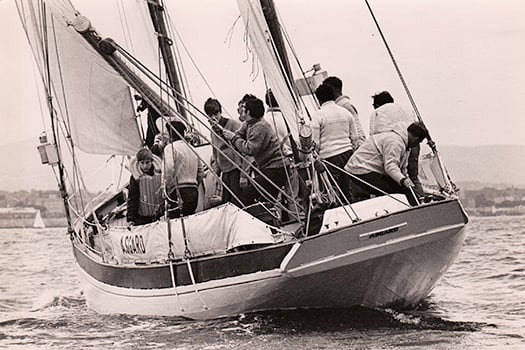
Michael Boyd has his first offshore sailing experience aboard the first Asgard in 1969.
Michael Boyd (64) may work in a demanding London-based international consultancy, and his Irish home may be in the depths of the country in the hidden northern reaches of County Meath, but in sailing terms he's Dun Laoghaire through and through. His father Liam was a stalwart of the Dublin Bay 21 class, and his own first forays offshore were as a youthful trainee aboard the 51ft ketch Asgard under Captain Eric Healy's command during the early days of the historic vessel's six seasons as Ireland's sail training vessel from 1969 to 1974.
At precisely the same time, just across channel in North Wales, his contemporary the young Eddie Warden-Owen was cutting a swathe through dinghy sailing at Treardur Bay and Holyhead. Very quickly, with a GP14 called Gwladys, he was achieving national success, and that in turn led to a career in sail-making and then on to professional sailing at the very top level – his success as coach in making a formerly lacklustre Italian campaign into serious contenders in the America's Cup is now text-book material in advanced sailing courses.

Michael Boyd's choice of a J/35 as his first serious offshore racer was a shrewd decision. He won the Round Ireland Race with the J/35 Big Ears in 1996, and more recently the J/35 has been one of the few exceptional boats to be inducted into American Sailing's Hall of Fame
As for Michael Boyd's sailing career, while it had to be fitted in with hyper-demanding international business commitments, he first really hit the headlines in 1996 with the overall win of the Round Ireland Race with his J/35 Big Ears. He was a regular and successful contender in RORC events, but these days his personal and family boat is through a partnership in the handsome Sparkman & Stephens-designed Maine-built performance cruising ketch Southerly, which is based at New Ross in County Wexford on the tidal section of the River Barrow, while his racing needs were met during 2014 by chartering the Grand Soleil 43 Quokka with fellow RIYC member Niall Dowling.
With Quokka, they were not only a much-valued part of the winning Irish Commodore's Cup team, but were top boat in Cork Week 2014 to win both the Hugh Coveney Cup and the historic 1859-vintage "Kinsale Kettle", a splendidly ornate and substantially-sized bit of Victorian silverware "which we were allowed to sit beside for just about ten minutes – there was no question of taking it home to Lobinstown".
The co-skipper of Quokka (they've chartered her again for 2015) is clearly an enthusiast who relishes our sport, and the ins and outs of sailing in all its ramifications. He makes an ideal person to be Commodore of the RORC at an important juncture in its development, and with Eddie Warden-Owen as the club's CEO, he has a kindred spirit with whom ideas can be developed and implemented at impressive speed.

Eddie Warden-Owen, CEO of the rapidly-developing Royal Ocean Racing Club. He was starting to hone his renowned racing skills at Holyhead just 54 miles across channel from Dun Laoghaire where, at exactly the same time, Michael Boyd was starting his sailing career.
So when your reporter had lunch with the new Commodore just eight days ago, he should have kept the main man strictly on track for a serious discussion of the challenges that club and sport face. And so we did for a while. But when you're with somebody with Michael Boyd's personal enthusiasm for participation sailing, dusty discussions on administrative matters have to run in parallel with wide-ranging and entertaining talk of sailing, boats, sailing folk and the wonders of the sea – the man certainly knows his boats and places and people .
Underneath it all, there was a good impression of the necessary range of his activities – for instance, in the week he became Commodore, he had to be in France for the RORC's Paris Dinner linked to the annual Boat Show there, and he is keenly aware of the club's global spread and the significance of people like Piet Vroon of the Netherlands and the Gouy family of France with their truly international approach to the sport and their regular participation in the Round Ireland Race.
Looking to the west, the club has a strong presence in the Americas, which has been reinforced with the annual RORC Caribbean 600 every February since 2009. This year it will see an uplift in the entries by hundred footers, notably by Syd Fischer's "new hull/original deck and rig" Ragamuffin 100 fresh from the Rolex Sydney Hobart Race, another event in which IRC is the key handicap system.
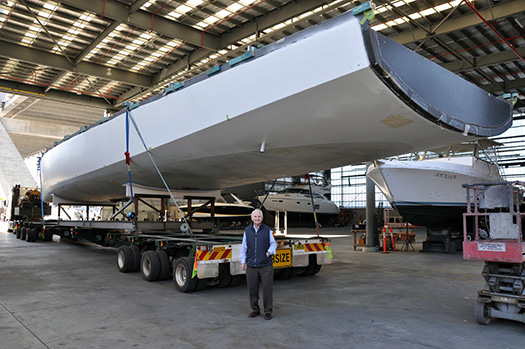
Definitely a sport for life. Syd Fischer, 87-year-old legend of Australian sailing, with the new hull for his hundred footer Ragamuffin just a few months before the recent Rolex Sydney-Hobart Race. Ragamuffin made it in time for the race, she took third on line honours, and now she is being shipped to Antigua to race the RORC Caribbean 600 in February.
But although in Australia the IRC is administered by Hobart race organisers the Cruising Yacht Club of Australia, for the biennial Rolex Fastnet in August and annual Rolex Middle Sea Race from Malta in October, the RORC's Rating Office, based in Lymington under the direction of Mike Urwin, is directly in charge. The Rating Office celebrated 30 years of the IRC Rule in 2014 with a growth in ratings issued after a slight decline during the years of economic recession, and the Lymington unit's unrivalled breadth of experience in the ways of bots and designers and offshore racing give it a special worldwide standing, yet another factor in the RORC's unique position in global sailing.
With their combined experience and proven administrative and international skills, the Boyd/Warden-Owen team are able to provide such formidable leadership for an organization which is central to our sport that they are able to do so in an under-stated way which is ideal for dealing with the highly-individualistic characters who are the leaders in their sport.
So when the London sailing-decision-season started in December with the new setup brought into being in the RORC, clearly things were moving in the right direction. Whether they continued to do so with the next item on the agenda, the Royal Cruising Club awards on January 8th, only time will tell. For this time round, I was the one in the hot seat adjudicating, and you feel the hand of history firmly on your shoulder when you're allocating a trophies which have been won in times past by the likes of Conor O'Brien.
But we'll return to that particular restrospective at the conclusion of this article – meanwhile, how did things go at the Old Gaffers Association AGM last Saturday? Sean Walsh of the Dublin Bay Old Gaffers Association became the first overall president from outside the southeast of England a year ago, so this was the first AGM under his guidance throughout, and it's not a task for the faint-hearted.

Sean Walsh, President of the OGA, sailing in company with the 100ft Viking ship Sea Stalllion.
As the Old Gaffers Association, with its 5,000-plus members in nine countries, is run almost entirely on a voluntary basis, their AGM is virtually a day long affair, a conference really, which started with an intense General Management Committee meeting (the GMC is made up of the Presidents and Hon Secs of each of the many branches) which is a two hour affair which started at 11am and concluded with a brief lunch break before the fully-fledged AGM took up the entire afternoon and went on well into the evening, a four hours-plus session which was to satisfactorily cover an exceptional range of topics.
The OGA may have had fairly casual get-togethers and an annual race or two as its main activities when it was founded in 1963. But now it has evolved into an active group with an impressively developing website and a widespread season-long programme which still has to take account of the notable individuality of the membership and the astonishing variety of their boats.
They even have a very active trailer section in which characterful yet trailerable gaff-rigged boats can suddenly appear in significant numbers at remote sailing locations – the highest lake in Wales, for instance – and they're developing the concept of "Raids" in attractive cruising areas. In these, the fleet keeps together by a relaxed form of racing in which the boat which has got into the lead is only allowed to stay there for five minutes, then she's obliged to go to the back of the fleet. If using the idea for larger slower-manoeuvring boats, you'd probably make the time at the front of the fleet a bit longer, but nevertheless it's a concept of great potential.
As for activities on the sea, while the main focus of 2014 was the Cruise-in-Company in the Netherlands to celebrate the tenth anniversary of the Dutch branch, in 2015 the focus will be on two cruises-in-company, one to St Malo in northeast Brittany to accommodate the large fleet numbers on the south coast of England and on both sides of the southern North Sea, and the other – aimed at the fleets in southwest England and on both sides of the Irish Sea – assembling at Kinsale on July 17th.
This fleet will go on westward for a week centred around the Glandore Classics, though with forays to the Fastnet Rock and other nearby ports. Glandore will then be followed by a further two weeks cruising towards West Kerry with a circuit of Skellig Michael the target, followed by more leisurely cruising homewards. In all, an epic three week venture which, like the OGA's successful Golden Jubilee Round Britain Cruise-in-Company in 2013, will probably see some boats joining and leaving at different intervals, though for most, staying the complete and very scenic course will be the target.
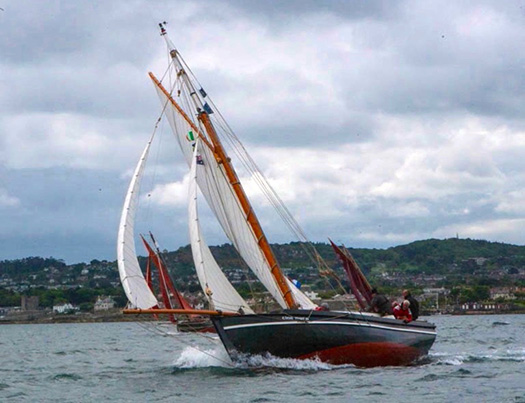
Cine Mara from The Netherlands. Rik Janssen's steel-built version of a traditional Galway Hooker, seen in Dublin Bay during the OGA Golden Jubilee Cruise-in-Company in 2013, was one of the flagships for 2014's Tenth Anniversary Cruise-in-Company for the Dutch Branch of the OGA. She is expected back in Ireland for the 2015 Glandore Classics in July, and the subsequent Old Gaffers Cruise-in-Company to West Cork and Kerry. Photo: Barry O'Loughlin
What with their intense GMC meeting in the morning, closely followed by his four hours and more of moderating the AGM in the afternoon over an exceptional range of topics, Sean Walsh and his team had a busy day of it. But as with any successful body, by the conclusion of the meeting the administrative officers were themselves re-enthused by the energy and commitment of their members. And from the Irish point of view, it certainly means that from July 18th to 24th we're going to have a CH Marine Glandore Classics Regatta 2015 on an unprecedented scale.
By contrast, the Royal Cruising Club works on the notion that small is beautiful. It has only 400 full members, but with a big history going back to 1880 when it was founded in London by a Trinity College Dublin graduate called Arthur Underhill, and its Challenge Cup goes back to 1896, which makes it far and away the world's senior cruising trophy.
In the early days, there were those cruising people who sniffed at the very idea of a "cruising competition". But contests such as this encourage the keeping of proper logs, which is an integral part of seamanship. And in an activity which is remarkably difficult to quantify, qualify and annotate, the story of the many winners gives us an unrivalled narrative of the development of cruising and cruising boats over the past 118 years.
Certainly it's something which the RCC - after some initial and understandable reluctance back in the early days – now takes very seriously indeed, so much so that the identity of the judge is kept an almost complete secret until the announcements go public in early January, and only a couple of others in the communications side of the club know the outcome of his or her adjudications after they've been made in early December – even the Commodore is kept in the dark until the January revelation.
The use of "his or her" in relation to the judge reflects the nature of this extraordinary club, which seems to have always had women members paying an active role. So much so, in fact, that it wasn't until after I'd made the list public that it was pointed out to me that of the awardees, more than half were women sailors. I simply hadn't noticed – I was only trying to highlight the twelve best cruises out of an impressive total of 40 logs submitted.
Most of the awards are of a relatively private or specialist nature within the club, but the Challenge Cup is of public interest – in the early days of the BBC radio, its recipient would be revealed on the airwaves. And another main award, the Cruising Club of America Bowl – went to a boat of Irish interest, the 44ft steel-built gaff yawl Young Larry (Andrew & Maire Wilkes) which is well-known about Dungarvan, as Maire was noted West Waterford solo sailor Maire Breathnach before she teamed up with Andrew.

The extensively-cruised steel gaff yawl Young Larry snugly moored in the pool just below the bridge in Dungarvan. Photo: Donal Walsh
This remarkable couple have also been recognised by the Irish Cruising Club, and in the spring they'll be presented with the ICC's Fastnet Trophy which is for exceptional achievements which have included a voyage circumnavigating North America, which of course included the east-west transit of the Northwest Passage. Having done and dusted the Northwest Passage, so to speak, in 2014 they returned to its southeastern approaches to cruise in detail the areas they'd to by-pass before, thus well-qualifying Young Larry for the CCA Bowl.
It's for a "cruise of any duration which includes a valuable contribution to Port and Pilotage information", and as Andrew and Maire's account of their cruise – which was via Ireland, Scotland, the Faeroes, Iceland, Greenland, Baffin island and Labrador before laying up for the winter in Newfoundland – is replete with sailing directions and anchorage information (sometimes obtained while in almost-too-close contact with polar bears), they fitted the Americans' requirements perfectly.
The Challenge Cup for the best cruise of the year has always had strong Irish associations, as in 1896 its first awardee (you don't "win" cruising trophies) was Dr Howard Sinclair of Belfast for a cruise round Ireland in his 23ft cutter Brenda. The pace and scale soon quickened, for in 1923, '24 and '25 it was awarded three years on the trot to Conor O'Brien of Foynes for his unprecedented global circumnavigation south of the great Capes in the Baltimore-built 40ft ketch Saoirse.
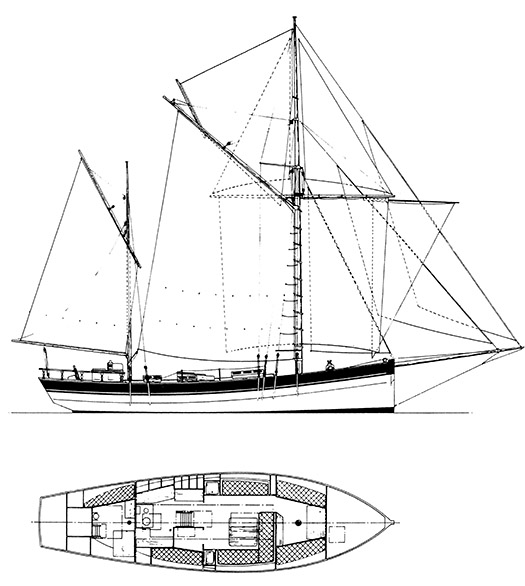
The Baltimore-built Saoirse. Conor O'Brien of Foynes was awarded the RCC Challenge Cup in 1923, 1924, and 1925 during his unprecedented global circumnavigation south of the great Capes in this 40ft ketch
More recently, Peter Guinness – originally of Howth – was awarded it in 1960 for an extensive cruise with the cutter Rob Roy McGregor, and then John Gore-Grimes from the same home port took it in 1985 for an exceptional Arctic cruise in the Nich 31 Shardana, the same skipper being honoured again for a long voyage north of Russia with the Najad 441 Arctic Fern in 2003.
Those who think the icy northern wastes are best left to polar bears will be cheered to learn that for 2014, I awarded the Challenge Cup to a sweet little own-built 34ft junk-rigged schooner which skipped across the oceans in the warmer zones like a flying fish. Then when she reached the end of each ocean voyage, her husband-and-wife crew would cruise each coastline visited as though that was the only cruise they'd be doing all year – in other words, with total enthusiasm and genuine interest in the people they met in some very obscure places.
But then, when you've a Jay Benford-designed Badger class schooner which you built yourself, you can comfortably fit in anywhere without offending the sensibilities of the locals by a gross display of affluence. Charlotte Waters – who is an artist – and her master craftsman/furniture designer husband Dan Johnson built their little boat Hestur with very limited resources near their cottage at Ullapool in Wester Ross in northwest Scotland. In their first season of 2013, they cruised to the Canaries via northwest Spain, then through 2014 they cruised on to West Africa and journeyed far up the Gambia River just before the outbreak of ebola, then went safely on their way to Cape Verde, across the Atlantic to cruise the Caribbean in detail, then on to Bermuda, the Azores, southwest Ireland, North Wales and so home to Ullapool leaving a very minimal carbon footprint in a voyage very worthy of the world's most senior cruising award.

Small and simple is beautiful and just right in a good cruising boat. Seen here far up the Gambia River in West Africa, this is the own-built Badger class schooner Hestur, whose owners Charlotte Watters and Dan Johnson of Ullapool in Scotland cruised extensively around and across the Atlantic. They have been awarded the RCC Challenge Cup for 2014. Photo: Charlotte Watters
Dublin Sailor Michael Boyd Named RORC Commodore in London
#RORC – Dublin Bay's Michael Boyd has been elected Commodore of UK's top offshore racing body, the Royal Ocean Racing Club (RORC). The 64–year–old Royal Irish Yacht Club sailor, a skipper in this year's winning Irish Commodore's Cup team, is only the second Irish sailor to lead the London club in its 89–year–history.
David O'Brien of the Irish Times has much more on the story in this morning's edition HERE.
#irishsailing – After five years of economic contraction, there are signs of recovery, and the 2014 Irish sailing season has also got off to a flying start. W M Nixon looks at various signs of new energy and initiatives, and sees how they might be affecting stories which have been run on this blog and in the Afloat.ie website during the past year. But he concedes that further cost reductions will be necessary for the good of the sport.
A year ago, any talk of green shoots in Ireland was almost entirely metaphorical. And it was in the economic sphere, though even there they were still few and far between, with many soon stunted. But out in the farmers' fields themselves, out where the grass should have been growing, there was scarcely a sign of life as we were still trapped in the coldest and most miserable Spring in living memory, and all forms of growth and recovery were blighted by it.
Sailing and boating, of all sports, are the most affected by Ireland's climatic conditions. Not only is the mood among participants strongly influenced by weather which sometimes can get anyone down, but without reasonable breezes, sailing events are seriously impaired. "We got a result!" may well be the PRO's final desperate claim after pulling some sort of a points table and leaderboard out of a series bedevilled either by too much or too little wind. But it's so much better to have a series bathed in sunshine and blessed by fine breezes, with enough races sailed for the crews to go home tired but happy without needing recourse to any of those weasel words which show you're only trying to justify a weekend of frustration.
Things could not be more different this year. The Spring of 2014 has been perfection, boats are going afloat on time and in reasonable weather conditions, and the first little crop of events and results are very encouraging indeed - so encouraging, in fact, that "little crop" doesn't do them justice.
That said, two of the nearer events which gave special cause for Irish celebration did not have perfect weather throughout. The Youth Sailing Nationals at Howth may have ended on a high with a great breeze in an early taste of summer sunshine, but one day out of the four was lost to bad weather. But the sting of that was lessened by the decision for "no racing all day" being taken at 1100hrs, which allows other leisure options to kick in.
The IRC Easter Championship in the Solent concluded through Easter Monday literally with "Darkness at Noon" – the heavy clouds and torrential rain on an almost windless day saw the final races being sailed with nav lights on. But there had been excellent racing on earlier days, and a very excellent result with Anthony O'Leary's Ker 39 Antix from Cork the clear supreme champion.
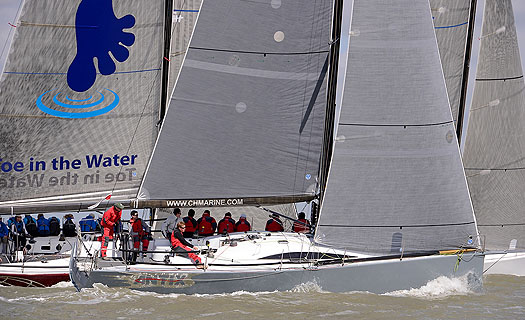
Doing the business. Anthony O'Leary's Ker 39 Antix settling into the groove on the way to the top place in the Easter IRC Championship. Photo: Rick Tomlinson
That in turn augured well for Ireland's Commodore's Cup chances, which then received a further boost last weekend when the crew of another Irish team wannabe, Quokka with Michael Boyd and Niall Dowling, had a winning weekend in the Warsash series with their temporary mount Tarka in anticipation of Quokka's return from the Caribbean at the end of May.

The Colours Match team racing between UCD and Trinity served up top sport in the Liffey, with Trinity winning. Photo: W M Nixon
Meanwhile the universities racing has been brought to life, for although UCD had a convincing win in the racing with the SailFleet J/80s to become the Irish team for the Student Yachting Worlds in France in the Autumn, before April was out the Colours Match in the Liffey under the burgee of the Royal Alfed YC, team-raced in Fireflies, saw Trinity take the honours in convincing style.
But if we're looking for something which really did set things freshly alight, it was out in Hyeres where the ISAF Championship saw the northern duo of Ryan Seaton & Matt McGovern take silver in the 49er, almost immediately moving them up the global rankings from 33 to 11, a quantum leap and no mistake.
The potential for serious success by these two has been fairly obvious for some time, but anyone who sails boats will know only too well how many factors have to come into alignment to get you up among the magic metals at the end of the day.

Stars of the silver sea – the Seaton/McGovern team took a silver medal for Ireland at Hyeres.
That their new global status was almost immediately acknowledged by this rankings improvement will in turn add heft to everything they do and say. Thus when, some time ago, the Ryan/Seaton equipe suggested that the 2016 Olympics sailing waters in Brazil are so off the standard as to be a health hazard, it attracted polite attention. But now that they're Number 11, and still counting down, much more notice is taken. And the fact that the Vice President of the International Olympic Committee has suggested, with something approaching despair, that the facilities in Brazil just aren't going to be ready for 2016 at any standard, all gives added legs to the statement from Ireland's 49er crew.
This in turn makes us wonder where world sailing might go in 2016 if the Brazilian setup is still Work in Progress. With tongue only slightly in cheek, we suggest they need look no further than West Cork, where Baltimore Sailing Club has been expanding its facilities to meet increased demand as a club which last year introduced something like 700 people to sailing. That BSC and current Mitsubishi Motors "Club of the Year" Kinsale YC further east along the West Cork coast have both been putting in premises up-grade during the past year, while other clubs have been having it tough, and just about hanging in there in some cases, surely gives pause for thought.
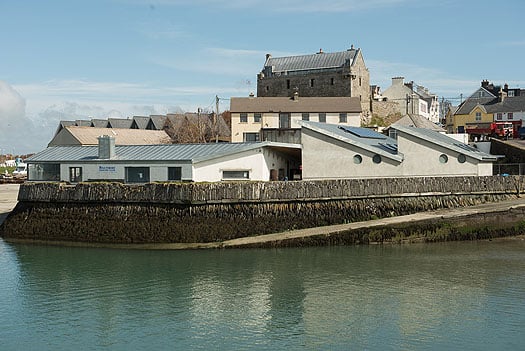
Olympic venue? The extended and up-graded Baltimore Sailing Club is ready and raring to go.
The economic shakeout of the past five years has caused a massive write-down in the value of almost all property and other assets. And in the case of yacht and sailing clubs, there has been a detailed examination of the continuing validity, or otherwise, of established yacht clubs and their traditional business model of quite high subscriptions under-writing other facilities which in turn combine to provide the complete package of an orthodox yacht club.
Inevitably, most clubs are run by officers and committee members who have been involved with the club for many years. Thus, like people who have been running a quality hotel for decades, they may have an inflated notion of what their organisation and its premises are actually worth. Admittedly there's only limited usefulness in comparing a yacht club with a hotel, but lessons can surely be learned. The fact is that hotels today are worth maybe only a third or even less of what they were reckoned to be worth six years ago. And equally, while yachts clubs certainly have a unique package to offer, is it unusual enough and special enough to charge high subscriptions when there are alternative facilities and services available?
The dilemma arises to some extent in all sailing centres. Last week we were discussing the story of the development of Howth YC. Today it is in the seemingly happy situation of having its own marina, thus it theoretically can offer an attractive all-in-one package to any potential member. But the very fact that Howth YC has done so much to help make Howth a colourful and vibrant sailing/fishing port is partly to its own disadvantage. The place has developed as a remarkable focus for top seafood restaurants. This means that the extensive club catering facilities – expected by traditional members - are constantly battling for business with a whole slew of award-winning eateries and characterful pubs nearby.
The problem is more acute in Dun Laoghaire in that the only club within the marina area is the Royal Irish YC. Thus while people may have been loyal members of the National, the Royal St George and the Dun Laoghaire Motor Yacht Club, they find that after going out in the boat, it's very easy to round out the evening aboard in the marina, chatting among themselves or with other crews on boats nearby, and then head straight for home without making their number in their home clubs at all.
This situation is less in evidence at weekends and during special events. But nevertheless it was causing such a lessening in mid-week club vitality that various steps have been taken, and the Royal St George's move to take over berths in a block booking in the outer marina, and service them by a frequent ferry direct from the clubhouse, is a visionary step.
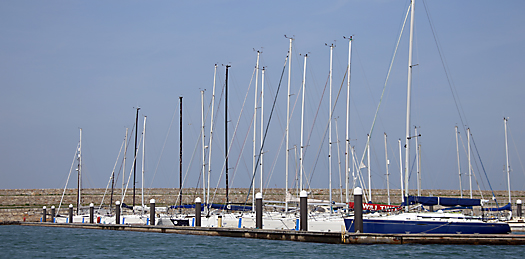
The Royal St George YC has introduced a direct ferry service from the clubhouse to its group of berths in the outer marina in Dun Laoghaire. Photo: David O'Brien
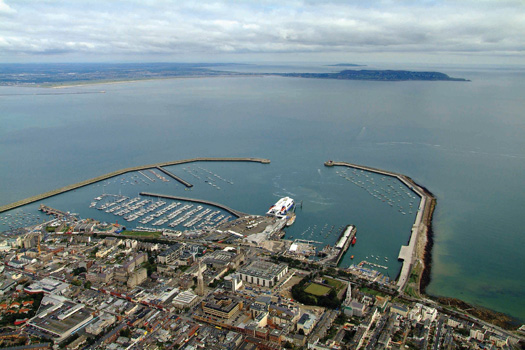
To overcome a lack of direct access to the Dun Laoghaire Marina, the Royal St George YC is running a ferry service from its clubhouse (to right of Stena Ferry, foreground) to the berths in the Outer Marina (upper left) Photo Kevin Dwyer/courtesy ICC.
Nevertheless, in all club administrations there are those who are of the opinion that, whatever the Honorary Treasurers may believe, there has to be a radical re-think of the primary subscription levels. In essence, they're suggesting that the book value of the club has to be written down such that subscriptions are halved. Personally, I haven't much of a notion of how to read a balance sheet, but the dogs in the street know that in the hospitality industry – which, in the broadest sense, is the area in which yacht and sailing clubs operate – values have been savagely slashed, and while charges may still seem high, at least the places are surviving as going concerns.
With continuing reduction in expenses across the board, one area in which there seems to be much work afoot is in the Irish Sailing Association, which in latter days had begun to seem like some hidden corner of the civil service, existing more for the benefit of staff than for the provision of services for sailors. It's amazing to learn that the ISA has sixteen fulltime staff, and a basic annual wages bill of something like €600,000. When you add in the expected benefits, it musty come in total to a very tidy yearly sum.
What on earth do they all do? While you'll invariably find the ISA logo in prominence at some top events, it has to be said that you're entirely unaware of the organisation's existence in any form at more everyday happenings, and it doesn't seem to be because they believe in doing good work by stealth. But with special study groups resulting from the major changes introduced in the ISA setup at the AGM in March, we can only hope that in time the Association will reflect the cost-cutting which has had to be introduced in the clubs, which provide the main part of the ISA's income.
While the administrative structures are rightfully being pared back in many areas of our sport, the coastal infrastructure, on which all forms of seagoing ultimately depend, continues to need maintenance and development. In this area, one very promising green shoot is the news that there are signs of movement in Dunmore East. A dredging programme is getting under way, and just this Tuesday, Minister for Marine Simon Coveney TD convened a meeting in the port to inaugurate a community approach to harbour development which, it is hoped, will help to invigorate the many places around Waterford Estuary, for which Dunmore East has the potential to be the true gateway harbour.

Dunmore East – can it fulfil its potential as the gateway leisure port for the Waterford Estuary? Photo Kevin Dwyer, courtesy ICC
In a more extreme marine environment, it has been confirmed that €6 million will be spent on improving the pier at Doolin in northwest Clare, the nearest mainland quay to the Aran Islands, which also caters for the tour boats cruising along the Cliffs of Moher. While the locals seem well pleased, I wouldn't get too excited about it. This is one very rugged part of the coast, and when you remember that it took €31 million to extend the pier at Kilronan in Inismor, the main Aran island, and another €14 million to build the little harbour at the north end of Inis Meain, the middle Aran island, then we can only hope that €6 million is going to achieve something more than a few boulders being shifted about in the roaring ocean at Doolin.

The pier at Doolin is decidedly minimalist, but it provides the shortest sea passage to the Aran Islands. Photo: W M Nixon
But then, in the west all things are possible, and along the ocean seaboard we're told that four thousand signs are being erected to guide people along the Wild Atlantic Way, the new tourism initiative using many smaller coastal roads. Quite so. Frankly, with signage at this level, it will be the Tame Atlantic Way by the time half of them are in place. I have to admit to being a complete curmudgeon in this. In many years of transitting Ireland's west coast by sea and land, one of our favourite areas while driving along the west coast has long been the coast south of Kilkee down to Loop Head, where the cliffs comfortably rival anything the vulgar Cliffs of Moher have to offer, and it is magnificently uncrowded. But not any more, if the Wild Atlantic Way movement has its way.
While I appreciate that visitor numbers have to be kept up and increased whenever and however, it has to be done in a way which appreciates that's what brings people to Ireland (rather than just to Dublin, which is a special case) is an unspoilt landscape. So, four thousand signs just for the one Atlantic Way? Ogden Nash had something to say about this:
"I think that I shall never see,
A billboard lovely as a tree.
But then, until the billboards fall,
I'll never see a tree at all".
Be that as it may, the final sign that suggests things are on the move again is a notice I spotted recently posted at a nearby club, though language pedants might wonder how a notice which manages to mangle so utterly the plural of "dinghy", even to adding a completely superfluous greengrocer's apostrophe, could be seen as encouraging in any way whatsoever.
Well, once you've overcome your opinions about the errors, the underlying message must be good news. More youngsters are evidently coming to sailing this year. And as for the spelling mistake, even that's an improvement. A year ago, the same notice board opened by referring to something called "a dingy", but this time round we have to get to the second line before finding that. And it all comes right for dinghies in the end.
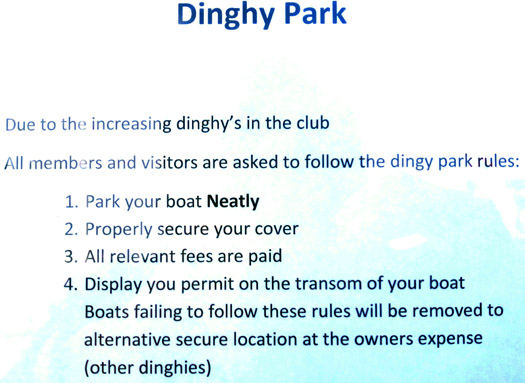
Sign of the times? Whatever about the spelling, this current notice at an Irish sailing club has an underlying message of good news. Photo: W M Nixon
Boyd's Quokka 8 Success at RORC's Caribbean 600 Trophy
#rorc – In another indication of the potency of this Summer's Irish Commodore's Cup team, the latest signing Quokka 8 skippered by Michael Boyd of the Royal Irish Yacht Club, has finished second overall in IRC2 at last week's RORC Caribbean 600 Trophy. Results here.
Last month, Irish team mates on the American Ker 40, Catapult, skippered by Peter O'Leary, achieved third overall in Key West regatta in Florida, leading Irish Commodore's Cup officials to conclude that Ireland has a winning combination for the Solent this Summer.
In a month of building excitement for ICRA and its Cup plans, it was finally announced an American and a British yacht would join Royal Cork's Antix to form the 'Green Team' for Ireland.
Although Afloat.ie accurately predicted the team line up some week's beforehand, refering to the team as 'Irish sailing's worst kept secret', such predictions were dismissed by ICRA Commodore Nobby Reilly as 'rumour'. Reilly took to Afloat.ie's popular comment section: 'Worst kept secret? The contracts have only just been signed so Afloat's original report was just a rumour. Fact is ICRA had 4 very competitive boats to choose from', he wrote.
The three boat team is Catapult, a Ker 40 owned by Mark Glimcher of the United States; Anthony O'Leary's Ker 39, Antix from Royal Cork; and the RORC Yacht Quokka, a Grand Soleil 43, being chartered by Royal Irish sailors Michael Boyd and Niall Dowling.
Although there will be a strong Irish crew involvement on all three boats comprising of sailors who first won the Cup for Ireland in 2010. Crew list announcements are awaited.
Meanwhile in Antiqua, Wwith all 60 yachts accounted for, the Royal Ocean Racing Club announced that the winner of the RORC Caribbean 600 Trophy for the best yacht, overall in IRC on corrected time, was George Sakellaris' RP72, Shockwave. The trophy was presented to the Shockwave crew at a Prize Giving held at the Antigua Yacht Club.
"I have a great crew and it was an excellent race, lots of wind and the racing was very close," commented Shockwave's owner/driver George Sakellaris, shortly after finishing the race. "I have done many offshore races but this is the first time I have raced this one and it was against tough opposition. I think the winds were favourable to us and the Shockwave team used that to our advantage. At the end of the day, winning yacht races is all about the team performance more than anything else."
"That is what ocean racing should be all about," commented Shockwave tactician, Robbie Doyle. "Beautiful racing between three very tough competitors, all fighting it out the whole way. A heavy-weight battle without a doubt - no question. I have had great moments in sail boats, but that was as much fun as I can remember. For 600 miles we were always in touch with each other, either up a few minutes or down a few minutes, and it all came down to the last beat to finish. It was like an epic tennis match. Every sail change was race critical. Bella Mente is a magic bullet when power reaching; we knew that before the start, so we set about minimising the time lost."
Robbie Doyle continued, "Bella Mente did a nice job getting through the lee of Guadeloupe by going inshore and at that time she had her time on us. All we tried to do was to stay in touch with her because we knew the race wasn't over. The critical point in the race happened just after Barbuda when Bella Mente got under a cloud and literally stopped and we sailed right up to them. After that we knew that if we just stayed in touch, the win would go to Shockwave - that's yacht racing for you, but what a fantastic experience."
"With all of the yachts now accounted for, the racing team can join the competitors at tonight's Prize Giving for a memorable occasion," commented RORC Racing Manager, Nick Elliott. "There have been some retirements, but we are delighted that there has been only minor damage to yachts. Apart from the expected knocks and bruises for a 600 mile race, everyone is safely ashore and looking forward to a great party."



























